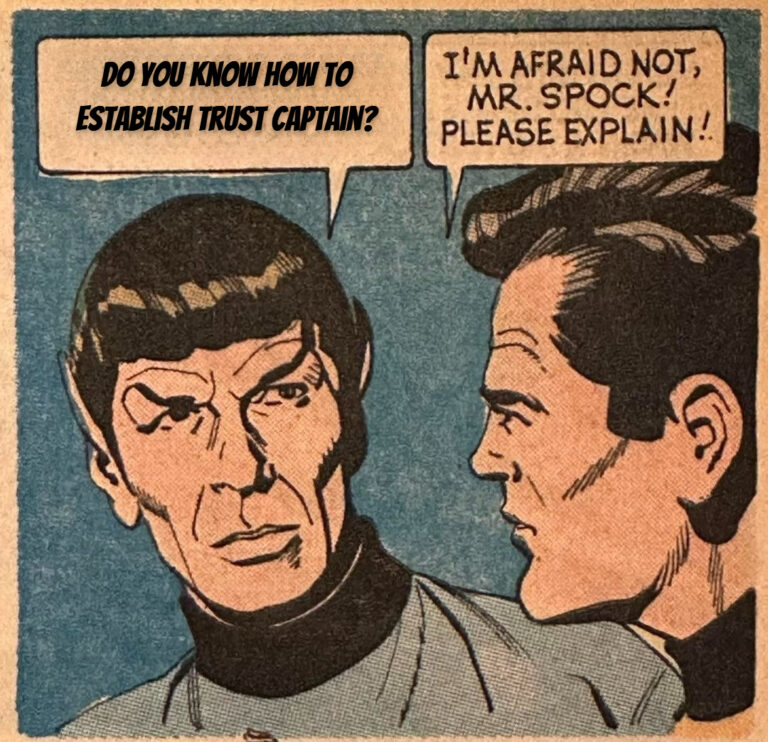
In the 90-Day Success Blueprint for New Software Product Management Leaders, we learned that there are five strategic priorities for a new product leader:
- Establishing product mastery unlocks decision-making superpowers
- Engaging stakeholders to align goals and gain support for the product strategy
- Managing their team to perform against product goals
- Getting things done to provide value to the organization
- And contextualizing their and their team’s work with the company’s culture

Each of the five tracks requires a concerted effort to ramp up. While any individual track may take precedence over others at various points in onboarding, it is crucial to make progress against all of them. Please do so to maintain performance for the product leader, their team, and the organization. Failure to do so will ultimately lead to a decreased ability to serve customers and provide them with valuable product outcomes.
The first onboarding phase builds trust across the organization by demonstrating progress against the five strategic priorities. Avoid the temptation of making important decisions to show decisiveness or action. You don’t have enough background knowledge or political capital to make calls affecting the organization. Of course, circumstances may require this, but those are not common and are outside the scope of a traditional onboarding process. If the organization the product leader is joining does require immediate action, the topic should be discussed during the interviewing process so the new product leader understands that the onboarding process will require explicit planning to address the immediate challenges that need to be addressed.
Month 1: Product Knowledge

The first month is critical for solidifying a foundational understanding of the product(s) you are responsible for. Dig deep into the core use cases, your ICPs, and the underlying technology.
Do this by recruiting others to run you through a Product Bootcamp to help you rapidly assimilate crucial details about the product’s functionality, market position, and development history.
As part of that, take the time to understand your products’ key performance indicators and metrics. If these aren’t readily available, add this to your to-do for your product ops stack.
Conduct first-hand interviews with users. Reading notes from previously conducted interviews helps, but inserting yourself in the process shines a light on how the team manages and values their user interactions. How easy is it to set these interviews up? If it is disproportionately tricky to invite yourself to scheduled interviews or arrange new ones, address this to your to-do list. Getting direct insights into how your team conducts interviews and hearing directly from your users will triangulate your team’s interviewing performance and how well your product meets your user’s expectations.
Create a Product Proficiency Report to detail your acquired knowledge and insights from user interviews and Product Bootcamp. This document will serve as your home for all things product and can serve as the benchmark for your growing expertise.
Month 1: Stakeholder Engagement

The lifeline of a product’s journey lies in the hands of its stakeholders – from engineering and design to sales, customer success, and marketing. Each group holds a piece of the puzzle, offering unique insights and resources essential for the product’s development and success in the market. The new leader must understand these diverse perspectives, align goals, and cultivate a collaborative environment, ensuring the product meets its targets and resonates across departments.
First 30 Days Focus: Building Bridges
The first 30 days for a new product management leader are less about drastic actions and more about laying a foundation of understanding, trust, and strategic alignment with key stakeholders. This approach paves the way for effective product leadership and ensures a smoother and more integrated journey for the product across the organization.
Focus on these activities during the first 30 days:
- Establishing Rapport: The first step is creating connections beyond professional courtesy. It’s about understanding each stakeholder’s challenges, motivations, expectations, and how the product impacts their department.
- Adopting a Listening Stance: This phase is less about speaking and more about listening. One-on-one meetings should be approached as a learning opportunity, gathering valuable insights about each department’s vision and pain points.
- Identifying Key Players: Understanding who the influencers and decision-makers are within each team is crucial. They are the ones who can champion the product and provide essential feedback or resources.
It’s crucial to emphasize that taking on too much or delving too deeply into details prematurely can derail the onboarding process. Engaging in overly ambitious projects or getting lost in the minutiae of operations can distract a new leader from establishing a strategic overview and building essential relationships. This misstep often leads to a superficial understanding of complex issues. It can strain relationships with stakeholders who may perceive this approach as overreach or need more respect for established processes. Moreover, it can overwhelm the new leader, leaving them less able to effectively prioritize and address the most critical aspects of their role during this formative period.
To that end, avoid the following:
- Steering Clear of Tactical Deep Dives: The initial focus should be on strategic alignment rather than getting entangled in the operational specifics of each department.
- Resisting the Urge to Initiate Immediate Changes: Building trust and understanding of the existing workflows should precede any proposals for change.
- Avoiding Premature Promises: Overcommitting early on, without a comprehensive understanding of the landscape, can lead to unrealistic expectations and tarnish the leader’s credibility.
Month 1: Team Management

It is also critical to lay a strong foundation in team management during your first 30 days. By conducting thorough diagnostic 1:1s, the new product leader can gain a deep understanding of team dynamics. Simultaneously, adapting and contextualizing your leadership style ensures that the new product leader effectively leads while establishing their leadership style with the new team and organization. This dual approach paves the way for building a cohesive, motivated, and high-performing group.
Diagnostic Interviews
The first step in effective team management is conducting diagnostic one-on-one meetings. These meetings are crucial to comprehend each team member’s perspective, gauge the team’s overall dynamics, and identify strengths and areas needing improvement.
Approach these 1:1s with an open mind and active listening skills. Encourage team members to share their views on their roles, operations, and challenges. This is not just about gathering information but building trust and showing that you value their input.
The insights gained from these sessions are invaluable. They provide a detailed picture of the team’s current state, enabling you to effectively make informed decisions and tailor your management approach.
Adapting and Contextualizing Your Leadership Style
As a leader, you have a unique style shaped by your experiences. Bringing this to your new role is essential, as it’s a testament to your leadership journey and success.
However, a crucial part of your early tenure is to adapt this style to fit the new organizational culture. This means understanding the nuances of the team and the company and molding your approach to align with these dynamics.
Aim for a balance between being consistent in your core principles and being flexible enough to meet the team’s and the organization’s specific needs. This might involve fine-tuning your communication methods, decision-making processes, or conflict-resolution strategies.
Month 1: Get Things Done

Evaluating and understanding current product delivery processes uncovers opportunities for quick, impactful wins, demonstrating early effectiveness and establishing a pattern of action-oriented leadership.
Understanding Existing Product Delivery Processes
The leader must first immerse themselves in the current product delivery methodologies. This involves understanding the existing process’s workflows, tools, timelines, and team roles. It’s crucial to recognize why specific strategies are in place and how they contribute to the product’s success.
This understanding should span all delivery aspects and cover product, engineering, and user experience processes. Interacting with those cross-functional teams is essential as it provides a holistic view of the process and offers insights into potential areas of improvement.
Comparing the existing processes with industry best practices can reveal gaps and opportunities. This evaluation should focus on efficiency, quality, and agility in delivering product updates or new features.
Identifying Low-Hanging Fruits for Immediate Impact:
Identify areas where minor adjustments can lead to significant improvements. You can optimize these processes or tasks quickly without extensive resource allocation.
Assess these potential changes based on their impact and the effort required to implement them. Focus on those that offer high impact with relatively low effort to create momentum and demonstrate early success.
Engage with the team to implement these changes and achieve quick wins to set the stage for a culture of continuous improvement and agility.
Share the results of these implementations with the team and stakeholders. Celebrating these early successes can build confidence in your leadership and foster a collaborative team environment.
Company Culture

Understanding and adapting to the company culture is a critical aspect of onboarding for a new software product management leader. It involves thoroughly exploring stated and practiced values and thoughtfully aligning your leadership style with the existing culture. Doing so ensures a smoother transition into the role and sets the stage for effective leadership and positive contributions to the company culture.
Understanding Stated and Practiced Company Values
Begin by familiarizing yourself with the company’s stated values, often found in mission statements, official documents, and internal communications. These values are the company’s aspirational principles and provide a framework for expected behaviors and decision-making processes.
It’s crucial to observe how these stated values translate into daily practices so that the product leader understands the nuances of how teams interact, make decisions, handle conflicts, and celebrate successes. Look for any discrepancies between the stated values and the actual behaviors exhibited within the company.
Engage with employees at various levels to understand their perspectives on the company culture through informal chats, lunch meetings, or structured conversations. These conversations can provide insights into the lived experience of the company’s values.
Aligning Leadership Style with Existing Culture
Once you fully grasp the company’s cultural landscape, adapt your leadership style to complement it. This doesn’t mean compromising your core values but finding a way to express your leadership that resonates with the team and aligns with the company’s culture.
While it’s essential to fit into the existing culture, a leader also has the opportunity to influence and evolve the culture positively. Identify aspects of your leadership style that can improve the current culture, such as promoting more open communication or encouraging innovation.
Continuously seek feedback on your approach and be willing to make adjustments. Doing so shows your commitment to being a part of the team and can help you refine your leadership style in a way that is both authentic to you and effective within the company’s cultural context.
Conclusion
The first 30 days are a period of intense learning, relationship-building, and strategic positioning. By focusing on these critical areas, a new software product management leader can effectively lay the groundwork for a successful tenure marked by solid team dynamics, stakeholder alignment, and a deep understanding of the product and the company culture.
Do's and Don'ts for New Software Product Management Leaders in the First 30 Days
- Do establish product mastery to enhance decision-making capabilities.
- Don't get lost in operational details and engage in overly ambitious projects early on.
- Do conduct first-hand interviews with users to understand their perspective and team's user interaction quality.
- Do engage stakeholders actively to align goals and garner support for product strategy.
- Don't make premature promises that could lead to unrealistic expectations.
- Do prioritize learning and relationship-building over immediate decision-making.
- Don't make hasty, important decisions without adequate background knowledge or established relationships.
- Do identify key influencers and decision-makers within teams for better product championing.
- Do conduct diagnostic 1:1s for a deeper understanding of team dynamics.
- Do integrate your and your team's work with the company's culture.
- Do adapt and contextualize your leadership style to fit the organizational culture.
- Don't ignore the nuances of how stated company values translate into daily practices.
- Don't fail to recognize and address any discrepancies between stated values and actual behaviors in the company.

